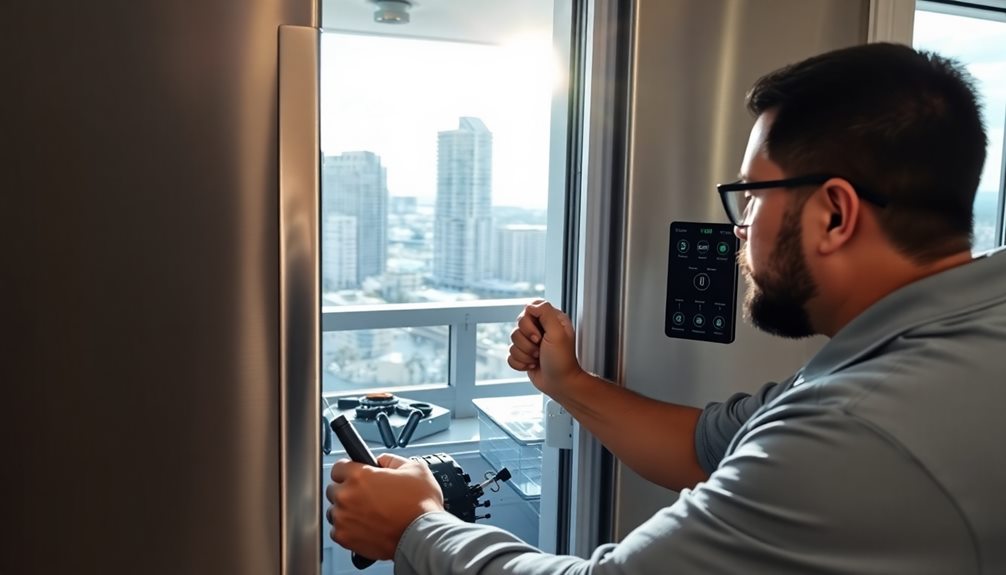Have you ever wondered how your microwave works? It uses electromagnetic waves to heat food quickly by exciting water molecules inside it. This molecular agitation generates heat, allowing for rapid cooking. The waves penetrate the outer layers first, which is why some dishes benefit from resting periods for even heat distribution. You'll notice non-polar materials like glass and plastic stay cool, while metals can cause sparks, so be cautious with your containers. Understanding these basics helps you use your microwave effectively, and there's much more you can uncover about its features and functionalities.
Key Takeaways
- Microwaves use electromagnetic energy to excite water molecules in food, generating heat through molecular friction.
- The heating process begins in the outer layers of food, requiring a resting period for even heat distribution.
- Metal objects reflect microwaves and can cause sparks, while non-polar materials like glass and ceramics remain cool.
- A magnetron generates microwaves, which are channeled into the cooking cavity via a waveguide for efficient energy distribution.
- Advanced features like sensor cooking and convection enhance cooking precision and versatility in modern microwaves.
Understanding Microwaves
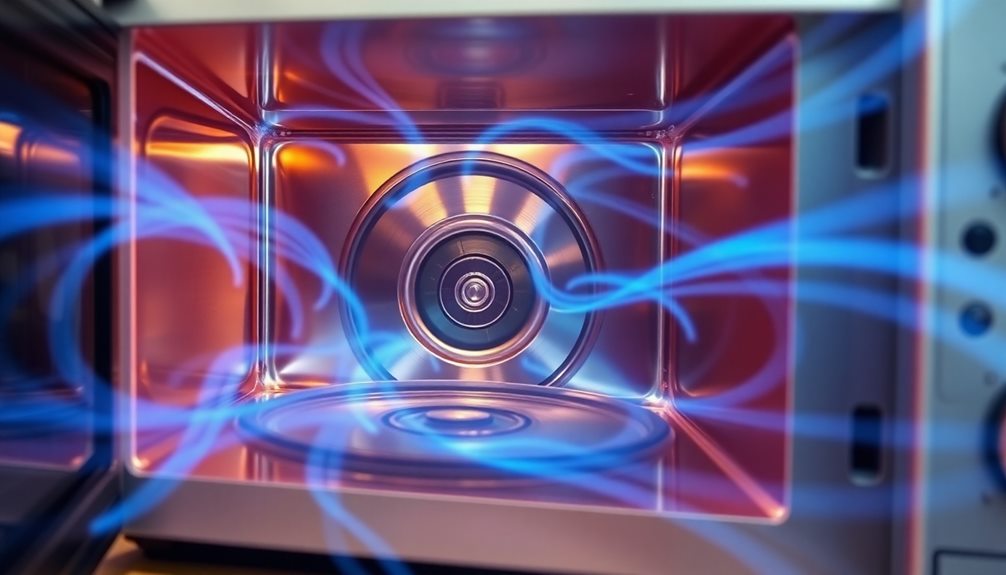
To get a grasp on how microwaves work, it's vital to understand what they are. Microwaves are a form of electromagnetic energy, sitting between infrared and radio waves in the electromagnetic spectrum. This unique position enables them to effectively heat food.
When you use your microwave, the energy primarily targets water molecules in the food. These molecules are polar, meaning they've a slight charge and react to microwave energy by vibrating.
As these water molecules vibrate, they generate heat, which cooks your food. It's a common misconception that microwaves heat from the inside out; in reality, they heat the outer layer first. That's why it's important to let your food sit for a moment after cooking, allowing the heat to distribute evenly.
You should also be aware that not all materials are safe in the microwave. Non-polar materials like plastics, glass, and ceramics won't heat up since they don't absorb microwave energy.
However, avoid using metal, as it reflects microwave energy and can cause sparks. Understanding these concepts will help you use your microwave more effectively and safely.
Heating Mechanism in Microwaves
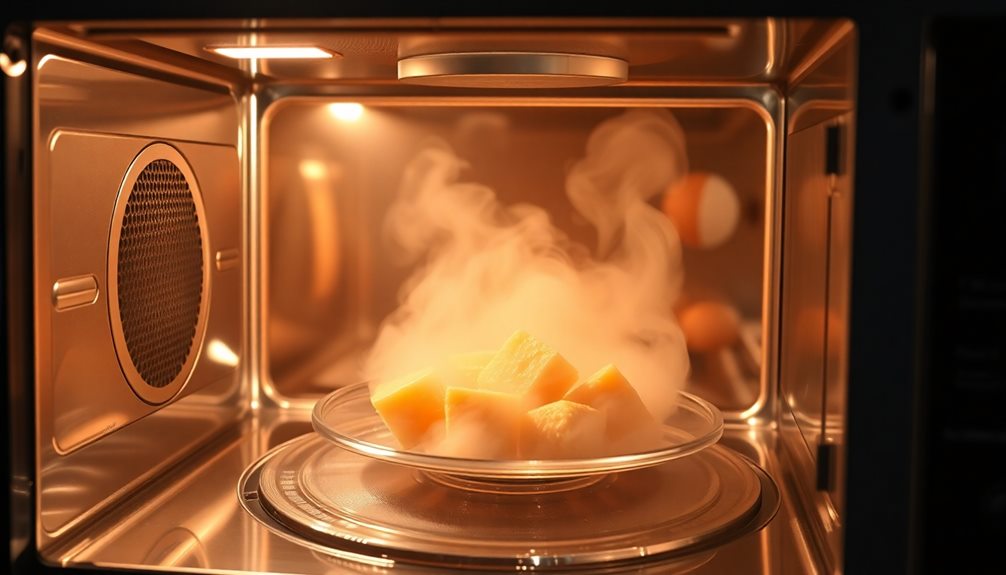
Microwaves heat food through a specific mechanism that targets water molecules, causing them to vibrate and produce heat. When you place food inside the microwave oven, the electromagnetic waves penetrate the outer layers first, which is why it's crucial to let cooked food rest. This resting period allows the heat generated to distribute evenly throughout the food, ensuring a thorough cooking process.
Unlike conventional ovens that transfer heat through conduction, microwaves rely on these waves to directly excite water molecules. Non-polar materials like plastics, glass, and ceramics don't absorb microwaves, so they remain cool while the food heats up. This efficient heating mechanism means that you can quickly warm up leftovers or cook a meal in mere minutes.
However, be cautious with what you place inside the microwave. Metal objects can reflect the microwaves, leading to sparking or potential damage to the appliance. So, always use microwave-safe containers.
With this understanding, we've got a clearer picture of how your microwave oven works, making your cooking experience not just faster but also safer.
Electrical Components of Microwaves
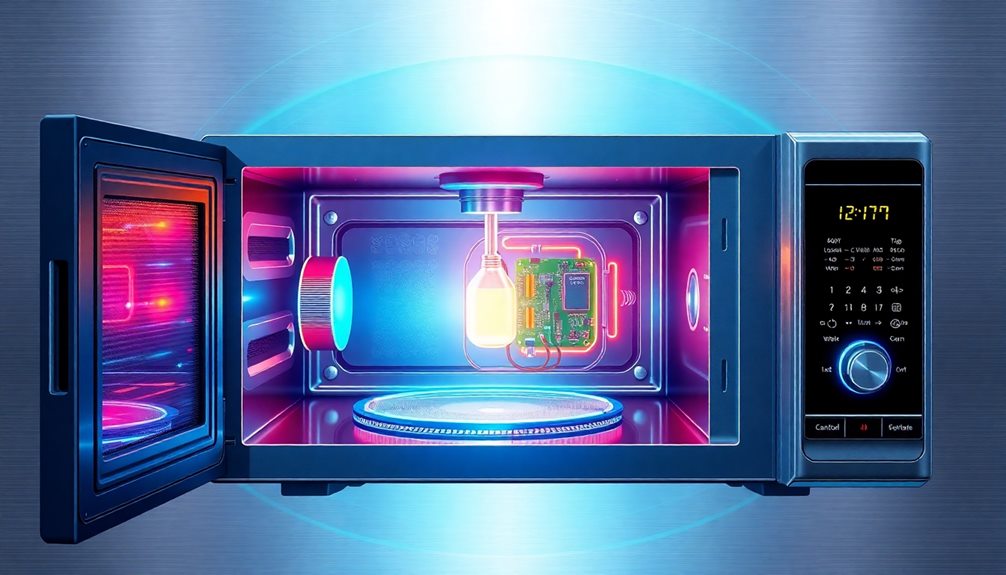
Understanding the electrical components of a microwave is fundamental for appreciating how this appliance operates safely and efficiently. At the heart of its functionality lies a transformer, which boosts the voltage from 240 volts to several thousand volts. This high voltage is essential for powering the magnetron, the component that generates microwaves.
As you use your microwave, electrical current flows through a fuse and filter board. These parts are significant for maintaining signal clarity, guaranteeing that the microwave operates smoothly.
To enhance safety, microwaves are equipped with a thermal cut-out switch. This feature prevents overheating by cutting power when temperatures exceed safe limits.
Another important safety component is the micro-switch. It instantly stops microwave emissions when you open the door, protecting you from exposure to microwaves during operation.
However, it's important to remember that the outer casing of a microwave should only be removed by qualified appliance engineers. This precaution guarantees both your safety and the proper functioning of the appliance.
Understanding these components helps you recognize the intricate design that keeps your microwave running effectively and safely.
Waveguide and Its Importance

Within the microwave's intricate design, the waveguide plays a significant role in channeling microwaves from the magnetron into the cooking cavity. This essential component guarantees efficient energy distribution, allowing your food to cook evenly.
Without a properly functioning waveguide, you might find that some areas of your meal are hot while others remain cold.
The waveguide also acts as a barrier, preventing food particles from entering the magnetron. This protection is important, as any contamination could lead to damage or malfunction of the microwave.
Typically made from durable materials like plastic or metallic card, the waveguide's design impacts its efficiency. Metal waveguides generally offer better durability, which is critical for consistent performance.
One of the unique aspects of the waveguide is its replaceability. If the waveguide cover becomes damaged or dirty, replacing it can restore peak microwave performance.
By maintaining this component, you help make sure that microwave energy is evenly distributed, leading to reliable cooking results every time you use your appliance.
Motors and Their Functions
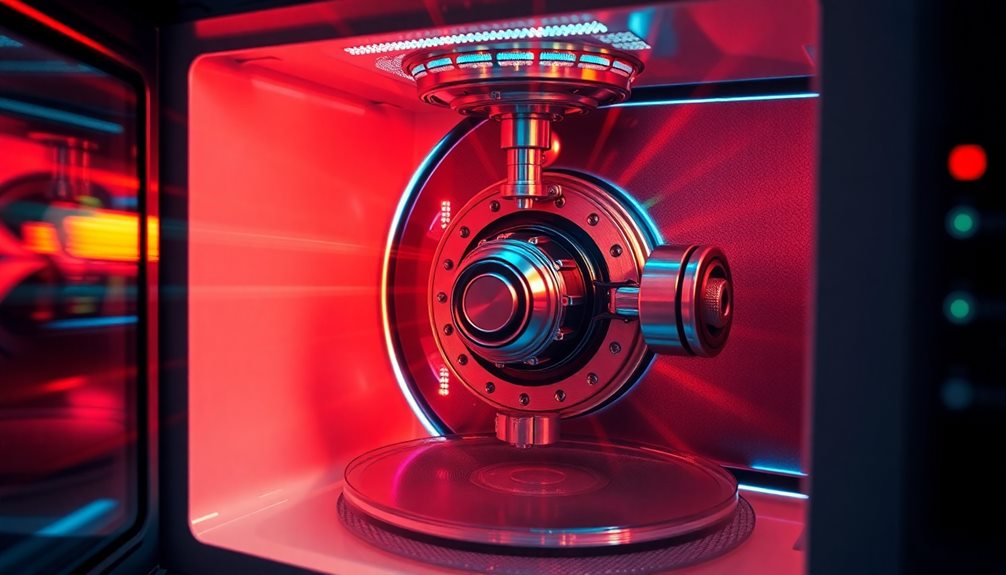
The motors in a microwave are vital for guaranteeing efficient operation and even cooking. One key component is the fan motor, which draws ambient air across the magnetron. This airflow keeps the magnetron cool and prevents overheating during operation. The fan circulates air around the magnetron and vents it outside, providing ideal cooling for the microwave to function effectively.
In addition to the fan motor, there's a second motor that rotates the cooking plate. This rotation helps distribute microwave energy uniformly across your food, promoting even cooking. Without this motor, you might end up with hot spots or unevenly cooked meals.
It's worth noting that the cooking plate itself is one of the most commonly replaced spare parts in a microwave, often due to wear and tear from regular use.
Keeping both motors in good working order is essential for your microwave to operate safely and thoroughly. If you notice any issues with the fan or plate rotation, it might be time to check or replace these components to guarantee your microwave continues to deliver delicious results.
How Microwaves Heat Food
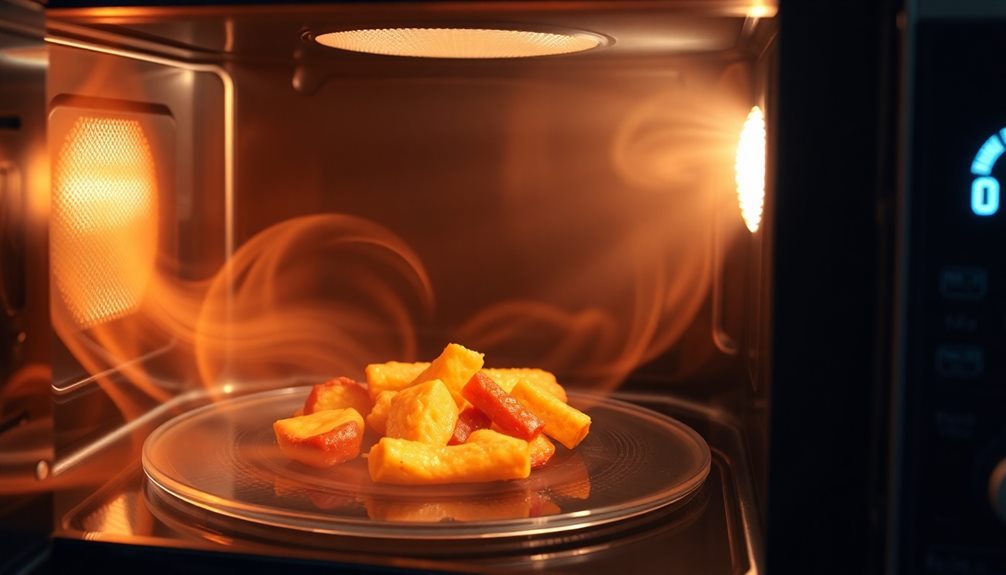
Microwaves quickly heat your food by causing water molecules to vibrate, generating heat through molecular friction. Inside your microwave, a component called the magnetron produces electromagnetic waves that penetrate your food, allowing for faster heating compared to conventional cooking methods.
This unique heating process differs from conventional ovens, which cook food by conduction from the outside in. Instead, microwaves heat the outer layers of food first, which can sometimes lead to uneven cooking.
To avoid this, it's a good idea to allow your food to rest after microwaving. This resting period helps redistribute heat throughout the dish.
Also, remember that non-polar materials like glass, plastics, and ceramics won't heat up in the microwave since they don't absorb microwave energy. However, avoid using metal, as it can reflect the waves and cause sparks.
For even heat distribution, consider using a turntable or manually rotating your food during the cooking process. This helps mitigate the hot and cold spots that microwaves can create, ensuring that your meal is heated evenly and thoroughly.
Benefits of Microwave Cooking

Cooking with a microwave offers several advantages that make it a popular choice in today's fast-paced world. You'll appreciate how it simplifies meal preparation and saves you valuable time.
Here are some key benefits:
- Time-Saving: You can whip up meals in just minutes, compared to hours spent on traditional cooking.
- Minimal Prep: With just a few button presses, your food can be cooked or reheated without extensive preparation.
- Versatile Cooking: Microwaves aren't just for reheating; they can toast, bake, and even broil, providing you with various cooking options.
- Energy Efficiency: Microwaves use less energy than conventional ovens, which means lower energy bills over time.
- Nutrient Retention: The shorter cooking times can help retain more nutrients in your food, so you enjoy healthier meals.
In a world where time is often limited, embracing microwave cooking can streamline your meal routine while keeping it nutritious and diverse.
Safety of Microwave Use
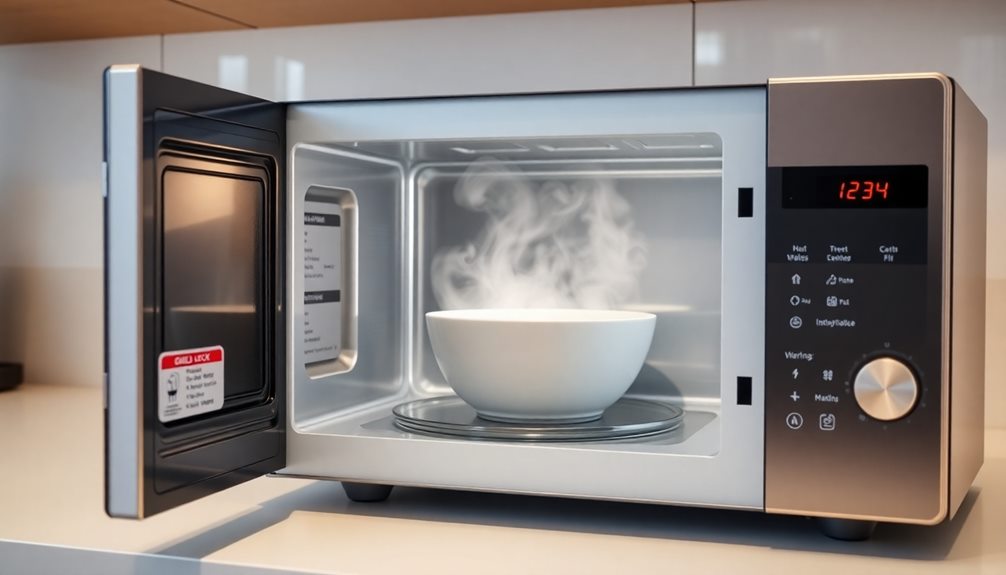
When using a microwave, it's vital to prioritize safety to prevent accidents and guarantee a smooth cooking experience. Always follow the manufacturer's guidelines for operation. This guarantees you're using the appliance correctly and reduces the risk of mishaps.
When you remove hot food, be cautious. Steam can escape, and surfaces may be hotter than they appear, leading to potential burns.
It's also important to note that thicker foods may cook unevenly, so allow them to rest for a few minutes after cooking. This resting period helps distribute heat evenly, making your meal safer and more enjoyable.
Use proper dishware, too. Make sure you're using microwave-safe containers to avoid hazards like melting or chemical leaching during heating.
Regular maintenance is significant as well; check the waveguide cover for cleanliness and replace it if necessary. A well-maintained microwave operates safely and effectively, reducing the chance of accidents.
Microwave Settings Explained

Understanding the various settings on your microwave can greatly enhance your cooking experience. By familiarizing yourself with the different options, you can achieve perfectly cooked meals every time.
Here's a quick rundown of some common microwave settings:
- Sensor Cooking: Automatically adjusts cooking time and power based on moisture levels in your food, ensuring ideal results without constant monitoring.
- Convection Cooking: Circulates hot air around your food, mimicking traditional baking methods for evenly cooked dishes with a crispy exterior.
- Combination Settings: Alternates between microwave and convection cooking, allowing you to combine speedy microwaving with the browning capabilities of convection.
- Top-Down Heat: Provides broiling capabilities, perfect for achieving a browned and crispy top layer on casseroles or meats.
- Keep Warm: Maintains the temperature of cooked food for up to 60 minutes, so your meal stays warm and ready to serve.
With these settings at your disposal, you can access the full potential of your microwave, making meal prep easier and more efficient.
Enjoy experimenting with these options to find what works best for your cooking style!
Shopping for Maytag Microwaves
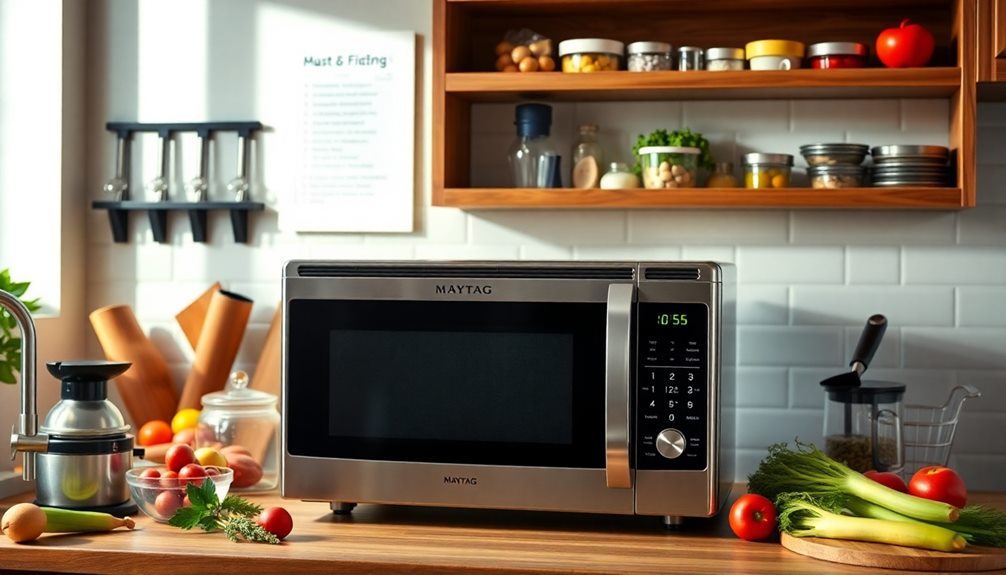
When shopping for Maytag microwaves, you'll appreciate their advanced features like convection cooking and sensor cooking that make meal prep a breeze.
These models offer versatile cooking options, combining baking, broiling, and toasting in one appliance.
With user-friendly controls and durable construction, you can trust a Maytag microwave to meet your everyday cooking needs.
Advanced Features Overview
Shopping for a Maytag microwave opens the door to a range of advanced features that elevate your cooking experience.
These innovative functionalities make meal preparation easier and more efficient, ensuring you get the most out of your kitchen appliance. With energy-efficient options available, you can also reduce your energy consumption while cooking, aligning with sustainability goals through energy-efficient technology.
Here are some standout features you can expect:
- Convection Cooking: Bake and broil with precision, mimicking traditional cooking methods right in your microwave.
- Sensor Cooking: Automatically adjusts cooking time and power based on the moisture level in your food for ideal results.
- Versatile Models: Options like the MMV1175JZ and MMMF6030PZ combine multiple cooking methods, enhancing your culinary capabilities.
- Keep Warm Setting: This feature maintains food temperature for up to 60 minutes, ensuring every meal is served perfectly hot.
- Enhanced Functionalities: Modern models cater to various cooking needs, from reheating leftovers to toasting snacks, making it a multifunctional kitchen solution.
With these advanced features, a Maytag microwave isn't just a microwave; it's a valuable addition to your kitchen that transforms how you cook and serve meals.
Versatile Cooking Options
Many home cooks frequently seek versatile cooking options to simplify meal preparation, and Maytag microwaves deliver just that. These appliances are equipped with advanced features like convection cooking, which lets you bake and brown food similarly to conventional ovens.
Models such as the MMV1175JZ and MMMF6030PZ showcase these multifunctional capabilities, allowing you to bake, broil, and toast all in one unit.
With sensor cooking technology, Maytag microwaves automatically adjust the cooking time and power based on the moisture detected in your food. This guarantees you get peak results every time, whether you're reheating leftovers or trying a new recipe.
The combination cooking settings alternate between convection and microwave cooking, giving you the flexibility to use various methods for your meals.
Thanks to these expanded functionalities, Maytag microwaves enhance traditional microwave usage, making them a valuable addition to any kitchen.
You'll find that meal prep becomes easier, allowing you to explore new cooking techniques and enjoy delicious results with less hassle.
Whether you're a novice or an experienced cook, a Maytag microwave can elevate your culinary adventures.
Frequently Asked Questions
What Was the Accidental Discovery of the Microwave?
The accidental discovery of the microwave happened when Percy Spencer noticed a chocolate bar melted in his pocket while testing radar technology. This led him to experiment, ultimately creating the first microwave cooking device.
What Is the History of the Amana Radarange Microwave Oven?
Did you know the first Amana Radarange weighed over 200 pounds? Introduced in 1947, it revolutionized cooking, leading to smaller, affordable models by the 1960s, making microwave ovens a staple in kitchens worldwide.
How Does Your Microwave Work?
Your microwave works by generating electromagnetic waves that cause water molecules in your food to vibrate, creating heat. It heats from the outside in, ensuring even cooking through components like the waveguide and rotating plate.
What Are 5 Disadvantages of Using a Microwave?
Using a microwave might seem convenient, but it can lead to uneven cooking, nutrient loss, leaching chemicals from plastics, altered texture, and over-reliance on quick meals that stunts your culinary skills. Isn't that worth considering?
Conclusion
Now that you know how microwaves work, you might still wonder if they really cook food evenly. Imagine this: placing a delicious, cheesy lasagna inside, and with just a few minutes, it's perfectly heated throughout—no cold spots! Microwaves use advanced technology to guarantee every bite is warm and satisfying. So, whether you're reheating leftovers or whipping up a quick meal, you can trust your microwave to deliver tasty results. Enjoy the convenience and deliciousness it brings to your kitchen!

